Question
A group of legislators wanted to look at factors that affect the number of traffic fatalities. They collected some data for 1994 from the National
A group of legislators wanted to look at factors that affect the number of traffic fatalities. They collected some data for 1994 from the National Transportation Safety Board on the number of fatalities for 50 states and the District of Columbia (DC), the number of licensed drivers, the number of registered vehicles, and the number of vehicle miles traveled.


(a) Copy and paste the data from this document to an Excel file. Select the Number of Traffic Fatalities as the dependent variable. Do a scatter plot between the Number of Traffic Fatalities and Number of licensed drivers (in thousands), a second scatter plot between the Number of Traffic Fatalities and the Number of Registered Vehicles (in thousands) and a third scatter plot between the Number of Traffic Fatalities and the Number of Vehicle Miles Traveled (in millions). Paste the scatter plots below and discuss the nature of the relationship based on the scatter plots. Note: Follow the instructions given in module 4 to do the scatter plots.
(b) Select the Number of Traffic Fatalities as the dependent variable and the Number of licensed drivers (in thousands), the Number of Registered Vehicles (in thousands) and the Number of Vehicle Miles Traveled (in millions) as independent variables. Conduct multiple regressions using Excel. Paste the output report below. Note: Follow the instructions given in module 4 to conduct simple regression. At the step where you specify the input data range, instead of selecting the data for one independent variable, select data for all the independent variables.
(c) Writethe equation from the regression output report. If you are using symbols in the equation for the variables, do define the symbols before using the symbols in the equation. Provide clear and complete interpretation of the coefficients b1, b2 and b3 in the equation. There is no need to interpret b0.
(d) What is the value of R2 for this model? Do you think that the model does a good job of explaining the variation in the number of traffic fatalities? Why or why not?
(e) Set up the hypotheses to test whether the model is significant. Is the regression model significant at 0.05 as the level of significance? What does this mean?
(f) Set up the hypotheses to test for each of the regression coefficients individually and perform the test at the 0.05 level of significance.
(g) What are your conclusions from the tests on individual coefficients? Do any variables need to be dropped? If so, rerun the regression and determine the final regression equation. Note: drop the variables one at a time starting with the variable with the largest p-value (least significant), rerun the regression without the data for the dropped variable, check the p-values again and continue the process until all p-values (other than for the intercept term) are less than the level of significance.
(h) Compare the final equation with the first regression equation. What recommendations do you have about using the final equation? Give reasons for your answer.
(i) Suppose there was a state with the following values of the independent variables: Number of Licensed Drivers (in thousands) = 3,500, Number of Registered Vehicles (in thousands) = 4,000 and Number of Vehicle Miles Traveled (in millions) = 45,000. Determine and interpret the predicted value of the number of traffic fatalities.
State Traffic Fatalities 1083 85 903 610 4226 585 310 112 69 2687 1426 122 249 1554 974 478 442 778 838 188 651 440 1419 AL AK AZ AR CA CO CT DE DC FL GA HI ID IL IN IA KS KY LA ME MD MA MI Licensed Drivers (thousands) 3043 443 2654 1770 20359 2620 2205 512 366 10885 4666 742 779 7548 3834 1921 1794 2498 2606 916 3311 4209 6602 Registered Vehicles (thousands) 3422 508 2980 1560 23518 3144 2638 568 270 10132 5638 781 1062 8331 4850 2929 1965 2615 3242 1071 3543 3956 7599 Vehicle Miles Traveled (millions) 48956 4150 38774 24948 271943 33705 27138 7025 3448 121989 82822 7935 11652 92316 62108 25737 24678 39822 37430 12469 44165 46990 85183 State Traffic Fatalities MN MS MO MT NE NV NH NJ NM NY NC ND OH OK OR PA RI SC SD TN TX UT VT VA WA WV WI WY 644 791 1089 202 271 294 119 761 447 1658 1431 88 1371 687 490 1441 63 847 154 1214 3186 342 77 930 638 356 712 144 Licensed Drivers Registered Vehicles (thousands) 2668 1659 3512 536 1154 987 878 5521 1162 10444 4779 443 7722 2363 2401 8146 682 2458 512 3583 12012 1203 435 4631 3741 1317 3542 354 (thousands) 3869 2056 4179 967 1490 983 1013 5752 1472 10428 5462 687 9647 2863 2748 8557 728 2764 845 5150 13287 1381 502 5593 4654 1375 4044 583 Vehicle Miles Traveled (millions) 43317 28548 57288 9116 15466 13019 10501 60466 20480 112970 71928 6338 98200 36980 29453 92347 7095 37245 7631 54524 178348 18078 6152 67609 47428 17112 50273 6689
Step by Step Solution
3.42 Rating (149 Votes )
There are 3 Steps involved in it
Step: 1
a We can note that there is positive correlation between Traffic Fatalities and the three explanatory variables SUMMARY OUTPUT Regression Statistics Multiple R 0982548538 R Square 096540163 Adjusted R ...
Get Instant Access to Expert-Tailored Solutions
See step-by-step solutions with expert insights and AI powered tools for academic success
Step: 2

Step: 3

Ace Your Homework with AI
Get the answers you need in no time with our AI-driven, step-by-step assistance
Get Started


